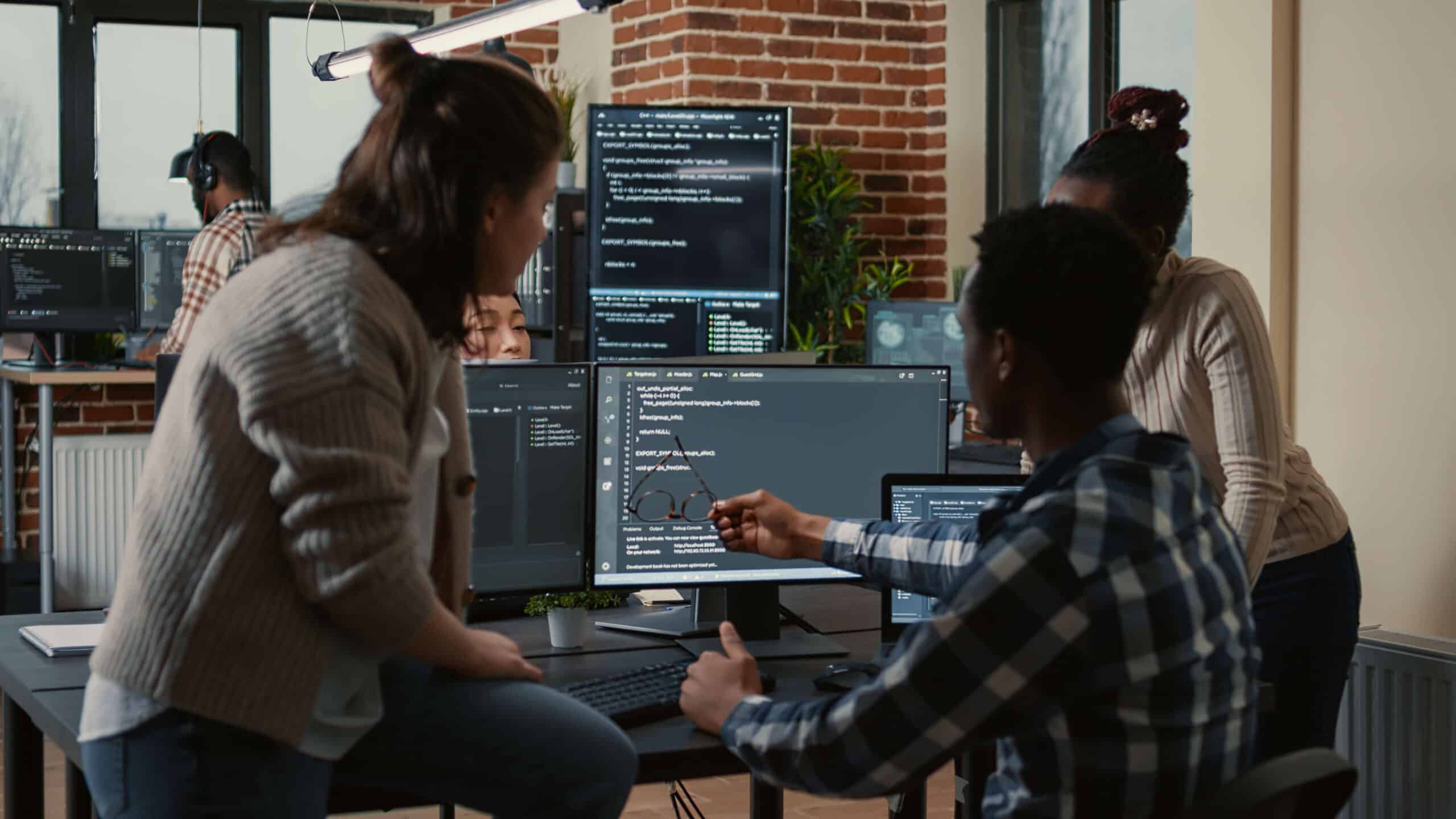Find out everything you need to know about being a Developer: salary, typical tasks, role, responsibilities and career development.
What exactly is a developer?
A developer is also known as a “programmer”, and is a person who designs, develops, tests and maintains a computer application (a website, software, a mobile application, etc.) The title of developer is a general, catch-all term.
The different types of developers
Full stack
A full-stack developer is someone with a versatile, all-round profile, with the ability to develop on both the front-end and back-end. The term “full-stack” refers to “all the layers of an application”. With this type of profile, it’s possible to build an entire application, from A to Z, by combining the skills of a front-end and back-end developer.
Front end
Front-end developers will have expertise in the design and creation of user interfaces, whether for mobile platforms, computers or tablets. They design and optimize these interfaces using technologies such as HTML, CSS and JavaScript, as well as modern frameworks like Vue.js, React or Angular. Their aim is to deliver a fluid, intuitive and visually appealing user experience, incorporating the concepts of UX/UI design, accessibility and compliance with web standards and requirements.
Back end
Back-end developers have expertise in data management, business logic, databases and interactions with servers. They design, develop and maintain the invisible infrastructure that feeds and supports the front-end, ensuring fluid communication between the different layers of an application. Their role is crucial in guaranteeing the performance, security, reliability and scalability of the entire system.
By skills
A language-specific developer is someone who focuses their expertise primarily on a specific programming language (e.g. Java / PL SQL / Angular etc.). This means they have a thorough understanding of the language, its paradigms, associated tools and best practices. Developers with this type of profile are useful for specific and critical needs, but will be less of a generalist than others.
The role and responsibilities of a developer
A developer can have a wide range of responsibilities, depending on his or her specialization. Here’s an overview of a developer’s responsibilities:
- Design: It’s essential to think upstream about the technical architecture needed to develop a feature, to ensure a solid foundation for the project.
- Back-end development: The back-end uses technologies such as Java, Python, Ruby or Node.js. This involves building the server logic, manipulating the data and, above all, developing APIs (application programming interfaces) that enable communication between the front-end and back-end.
- Front-end development: The front-end is created using technologies such as HTML, CSS and JavaScript, as well as frameworks such as Angular, React or Vue. The aim is to design user-friendly, responsive interfaces, adapted to cope with the constraints of the web and deliver an optimal user experience.
- Digital accessibility: Digital accessibility means making digital content and services understandable and usable for people with disabilities, and this involves interface designers and then front-end and mobile developers.
- Database management : Designing, managing and optimizing the database is vitally important when it comes to ensuring the reliability and performance of the application. Knowledge of technologies such as SQL is useful.
- Testing and debugging: Writing unit, integration and functional tests are essential for guaranteeing code quality. This also includes testing and debugging functionalities, whether front-end or back-end.
- Deployment: Deployment skills are crucial, especially with the widespread use of continuous integration and deployment (CI/CD). Pipeline management ensures reliable, automated deployments as development progresses.
- Communication: A development team can include various profiles such as UX/UI designers, testers, business analysts, product owners and so on. It is therefore important to know how to communicate effectively with all stakeholders, to ensure cohesion and alignment within the project.

What skills do I need to become a developer?
Here is a list of skills that correspond to a developer’s profile, depending on his or her specialization:
Design and architecture
- Software architecture: learn about the different architecture models (MVC, microservices, serverless) that can be used to design a coherent, scalable structure that meets the organization’s needs.
- API design: Design well-structured, documented and easy-to-use APIs to interact with other applications.
- Design patterns: In-depth knowledge of design patterns (such as Singleton, Factory, or Observer), to solve recurring design problems efficiently.
Front-end development
- HTML, CSS and JavaScript: master these three fundamental technologies so you can create appealing, interactive user interfaces.
- Front-end frameworks: Get to grips with modern frameworks like React, Angular and Vue.js, so as to develop dynamic, responsive web applications.
- Responsive design: designing interfaces that can be adapted to suit different devices (mobiles, tablets, computers) for optimal user experience.
- Accessibility and UX: Design interfaces that are accessible to all users, taking into account best practices in accessibility and user experience.
Back-end development
- Back-end language: Master at least one server-side language, such as Node.js, Python, Ruby, Java or PHP, to manage application logic and database interactions.
- Framework: Familiarity with frameworks such as Express (Node.js), Django (Python), Ruby on Rails, or Spring (Java), to structure and accelerate back-end development.
- API REST: design and develop APIs to facilitate communication between the front-end and back-end.
- Security: know about security principles (authentication, authorisation, protection against common attacks such as XSS, CSRF and SQL injections) to ensure that your application is secure.
Database management
- Relational database: Master SQL databases such as MySQL, PostgreSQL or SQLite, to organize and manage structured data.
- Non-relational databases: Learn how to use NoSQL databases like MongoDB, Cassandra or Redis to manage unstructured or semi-structured data.
- Query optimization: Learn how to optimize SQL queries and design a high-performance database architecture to avoid slowdowns.
DevOps and deployment
- CI/CD: Good knowledge of Continuous Integration and Continuous Deployment, to automate testing and deployment during development and production (Gitlab CI/CD, Jenkins etc).
- Containerization and orchestration: Learn how to use Docker to create containers and Kubernetes to deploy and manage applications in a distributed way.
- Cloud Computing: Cloud skills (AWS, Azure, Google Cloud) for deploying and managing resources.
Test and quality
- Unit testing: Learn how to write unit tests to check the reliability of basic functions and guarantee that there are no regressions in new developments.
- Integration and functional testing: Prepare and carry out integration and functional tests to ensure that the application as a whole functions correctly.
- Debugging: Use debugging tools to identify and correct code errors efficiently.
Soft skills
- Communication: Communicate clearly and explicitly with stakeholders, to ensure everyone is aligned with project objectives.
- Time management and organization: be able to prioritize and effectively manage front-end and back-end tasks, as well as day-to-day contingencies.
- Analytical skills: Analytical approach and ability to solve technical problems methodically.
- Continuous improvement: Evolve with technology and be proactive about learning new skills to stay up to date.
How much does a developer earn?
A developer’s salary will evolve as they gain more experience and develop a specialization (back-end, front-end, full-stack, mobile etc.), but is also determined by their location. A developer’s salary will vary depending on where they are based in Switzerland. Lastly, amounts may vary depending on the size of the company (large group, SME, start-up), the technologies mastered and the company’s field of activity.
- Junior (0-2 years): CHF 60,000 to CHF 90,000 gross per year.
- Advanced (2-5 years): CHF 90,000 to CHF 110,000 gross per year.
- Senior (5 years and over): CHF 110,000 to CHF 140,000 gross per year.
What degree do you need to get this job?
There are several paths to becoming a developer, depending on your goals and learning preferences:
University
Bachelor
- A 3-year degree that provides a solid foundation in front-end and back-end development, database management and other skills required for a role in development.
Example: Bachelor’s degree in Computer Science
Master’s
- A 2-year diploma that deepens skills in IT development and project management, with possible specializations in web technologies or software specialization.
Example: Master’s degree in Computer Science, Master’s in Computer Science and Software Engineering, etc.
HES (Haute École Spécialisée - University of Applied Sciences)
A 3-year diploma that places greater emphasis on the technical and practical skills sought by employers, such as application development, databases, networks, web and mobile development. This diploma prepares students to enter the world of work after graduation.
Example: HES Computer Science and Communication Systems or HES Computer Science or HES Business Computer Science
ES (École Supérieure - Graduate School)
A 2 to 3-year professional diploma, focused on the acquisition of technical and practical skills, such as software development, database management, networks, web and mobile technologies. An ES diploma prepares students to enter the job market as soon as they graduate, particularly in skilled technician or developer positions, in direct response to industry needs.
Example: Informatics ES or Business Informatics ES
CFC (Certificat Fédéral de Capacité - Federal Certificate of Proficiency)
A 4-year work-study program with a practical focus, delivered by vocational schools and training companies. It gives students hands-on experience as developers.
Example: Computer scientist CFS
Bootcamp
Intensive training, generally lasting from a few weeks to a few months, with a strong emphasis on the practical and technical skills expected by employers in the field of development. This type of program teaches the basics of application development, databases, networks, and web and mobile development.
Example: Le Wagon, Constructor etc.
Self-taught
Many developers are self-taught using online training platforms such as OpenClassrooms, Udemy or Codecademy. Ce parcours convient bien à ceux qui préfèrent apprendre de manière flexible et qui ont la motivation de progresser de manière autonome and enables early specialization.

What are the prospects for career development? What career paths are possible?
Once they have a few years’ experience under their belt and a solid grasp of the various facets of development, a developer may consider moving on to roles such as:
- Full-stack developer: A versatile all-rounder, with the ability to develop on both the front-end and back-end. The term “full-stack” refers to “all the layers of an application”. With this type of profile, it’s possible to build an entire application, soup to nuts.
- DevOps: DevOps combines development and operations management. This role is more focused on automating deployment pipelines, continuous integration and managing server environments, while still taking note of back-end responsibilities.
- Tech Lead: lead and supervise development teams, ensuring the technical quality of projects and providing advice on solving complex problems.
- Technical architect: design and structure project architecture, ensuring scalability, security and performance of all technical components.
- Technical project manager: manage projects by combining technical expertise and team coordination, to ensure compliance with deadlines, budgets and quality standards.
- Product Owner: drive the product vision by defining and prioritising functionalities to meet business needs and user expectations.
- Trainer: Pass on your technical expertise and support other developers in their development, either by working in training establishments or by offering training courses in the private sector.
What are the challenges in the life of a developer?
The main challenge for a developer is to keep abreast of new technologies. Technologies and tools evolve at a rapid pace, particularly in development. To remain competitive and successful, developers must constantly monitor technological developments, learn new languages, frameworks and practices, and regularly update their skills in a number of areas.
Understanding the business rules that need to be implemented is also essential when it comes to meeting requirements effectively. However, depending on the project, it can be difficult to adapt and master the specifics of existing rules, especially when they are complex, poorly documented, or change during the course of the project.
What jobs are similar to that of a developer?
- Front-end developer : Using their front-end development expertise, they design and implement the user interface of web applications, using technologies such as HTML, CSS, and JavaScript, with frameworks that enable them to deliver an intuitive and responsive user experience. They often collaborate with designers and product teams to translate mock-ups into functional interfaces.
- Back-end developer: expertise in back-end development, dealing with server logic, database management and API implementation to ensure server-side applications run smoothly. These developers focus on the performance, security and scalability of the technical infrastructure.
- Full-stack developer: A full-stack developer is someone with a versatile and complete profile, able to develop on both the front-end and back-end. The term “full-stack” refers to “all the layers of an application”. With this type of profile, it’s possible to build an entire application, from start to finish.
- Mobile developer: A mobile developer specializes in creating mobile applications for platforms such as Android and iOS. He or she uses tools like Kotlin, Swift, or React Native, and although the focus is different from full-stack, a mobile developer can also be versatile and skilled at both back-end and front-end in some cases.
Companies currently recruiting developers in Switzerland
Many companies in Switzerland are currently looking for developers. Are you looking for a job? Check out our job offers here.







